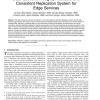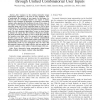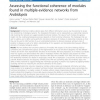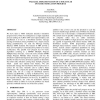319 search results - page 42 / 64 » Combining Multiple Weak Clusterings |
TDSC
2010
13 years 3 months ago
2010
This paper introduces dual-quorum replication, a novel data replication algorithm designed to support Internet edge services. Edge services allow clients to access Internet service...
TIP
2010
13 years 3 months ago
2010
One weakness in the existing interactive image segmentation algorithms is the lack of more intelligent ways to understand the intention of user inputs. In this paper, we advocate t...
BMCBI
2011
13 years 18 days ago
2011
Background: Combining multiple evidence-types from different information sources has the potential to reveal new relationships in biological systems. The integrated information ca...
EUROSYS
2007
ACM
14 years 6 months ago
2007
ACM
Dryad is a general-purpose distributed execution engine for coarse-grain data-parallel applications. A Dryad application combines computational “vertices” with communication �...
WSC
1998
13 years 10 months ago
1998
We have taken a NIST molecular dynamics simulation program (md3), which was configured as a single sequential process running on a CRAY C90 vector supercomputer, and parallelized ...




